|
|
The features on this page require a GENESIS64 Advanced license and are not available with GENESIS64 Basic SCADA . |
|
|
The features on this page require a GENESIS64 Advanced license and are not available with GENESIS64 Basic SCADA . |
On the Tag Logging Options tab of the Hyper Historian Tag configuration form (shown below), the Log to Disk configuration in Hyper Historian allows you to specify if all samples collected by the Collector are to be logged or if the collector is to perform an advanced filter on the samples instead. Use filters to limit the volume of data sent to the logger. By limiting data in this way, you can improve efficiency by significantly cutting down on network traffic. If you choose an advanced filter such as the Moving Average, the Hyper Historian collector will perform the Moving Average calculation on the raw samples over the defined calculation period (defined when setting up the Collector for the tag). The result of the calculation will be logged at the end of each calculation period.
|
|
Tip: The Log to Disk option only determines which values get sent to the Logger, not whether they are saved to disk. Values are saved to disk only if the logger configuration is Disk based or – if it is a Memory Persistent Logger configuration – is configured to save values to a file. Even after a value is forwarded to the Logger, you can configure the tag so that additional filters (the Deadband and Swinging Door filters) are applied to subsequent incoming values. For more information, refer to the Data Logger in Hyper Historian topic. |
You do have the option to send all collected values by selecting the All Samples option (which is the default). However, using the Log to Disk filter can save you network traffic, RAM, and disk space if you can still get the data you need with the calculations performed.
Log to Disk Options on the Hyper Historian Tag's Tag Logging Options Tab
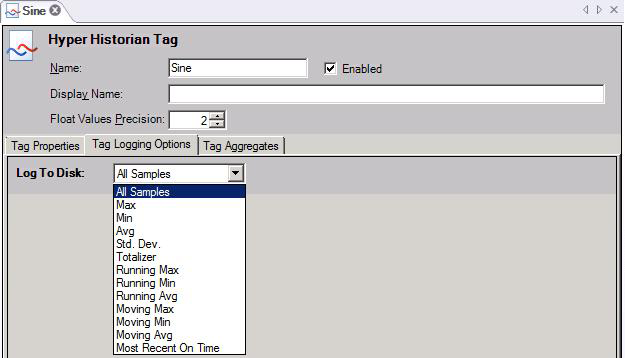
|
|
Note: The Log to Disk field is not available if the Is Collected check box is empty on the Tag Properties tab. A tag's Log to Disk option is applied to data in the collector. If the tag's data is written directly to the logger, no Log to Disk options can be applied because the data never passes through the collector. |
When choosing a Log to Disk filter, keep in mind the following:
If you’d like to filter an OPC tag’s data in multiple ways, you can create additional Hyper Historian tags, one for each Log to Disk filter you want to use for the OPC tag. For example, if you want to send the minimum, maximum, and average values to the logger, you can configure three Hyper Historian tags, one for each type of filter.
The calculation period (which is specified in the collector group’s configuration) is considered for only those options marked below with the symbol ‡. Such options consider only those values collected inside the calculation period if the Override Calculation Period check box is empty, and one value is sent to the logger for each calculation period. However, you can override the calculation period for the ‡ marked options by checking the Override Calculation Period check box and providing an override period. In this case, one value is sent to the logger before the memory buffer is cleared.
Some of the Log to File options do not render some data types, so always consider the tag’s data type (in the Data Type field) when choosing from the Log to File list. For example, choosing an average for a String data type will result in no data being logged.
The Stepped Interpretation check box is used primarily during playback, for interpreting the tag’s data values. This feature is applied only if you request a value for a certain point of time. The returned value will be the nearest older value available. In general, if the data comes from a discrete signal such as an on/off switch (a Boolean data type), you can put a check mark in the Stepped Interpretation check box; but if data comes from a sine wave or analog signal, leave the box empty.
From the Log to Disk pull-down list for Hyper Historian tags (described in the Hyper Historian Tags topic), you can choose one of the filters described below.
If you don’t want to filter samples before they are sent to the logger, select the All Samples option. As a result, all collected values are forwarded to the Logger. But if you do want to send calculated values (before the Deadband and/or Swinging Door filters are applied), select one of the options offered in the Log to Disk pull-down list:
Each is described below. Settings for each Log to Disk filter are described at the end of this topic, in the Settings for Each Log to Disk Filter Option section.
If you want only a minimum value to be sent to the logger, you can choose one of the following Log to File filter options. Settings for each filter are described in the Settings for Each Log to Disk Filter Option section at the end of this topic.
Min ‡ (minimum) – At the end of the calculation period, the lowest value collected during the calculation period is sent to the logger; all other values collected during the calculation period are discarded.
Moving Min ‡ (moving minimum) – The calculation period moves forward each time a value is collected, creating a sliding window of time from which the lowest value is determined. The lowest value collected during the sliding calculation period is sent to the logger.
Running Min (running minimum) – Each collected value is compared to the lowest value logged thus far since the beginning of data collection for the Hyper Historian tag. When a new low value is collected, it is sent to the logger. All subsequent incoming values are then compared to this new low.
Settings for Minimum, Moving Minimum, and Running Minimum
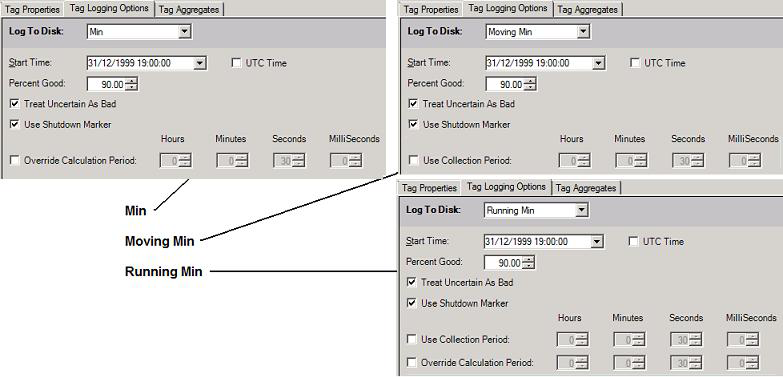
If you want only a maximum value to be sent to the Logger, you can choose one of the following Log to File options. Settings for each filter are described in the Settings for Each Log to Disk Filter Option section at the end of this topic.
Max ‡ (maximum) – At the end of the calculation period, the highest value collected during the calculation period is sent to the logger; all other values collected during the calculation period are discarded.
Moving Max ‡ (moving maximum) – The calculation period resets each time a value is collected, creating a sliding window of time from which the highest value is determined. The highest value collected during the sliding calculation period is sent to the logger.
Running Max (running maximum) – Each collected value is compared to the highest value logged thus far since the beginning of data collection for the Hyper Historian tag. When a new high value is collected, it is sent to the logger. All subsequent incoming values are then compared to this new high. Values are logged at the collection rate.
Settings for Maximum, Moving Maximum, and Running Maximum

If you want value averages to be sent to the Logger, you can choose one of the following Log to File options. Settings for each filter are described in the Settings for Each Log to Disk Filter Option section at the end of this topic.
Avg ‡ (average) – At the end of the calculation period, the average of all values collected during the calculation period is sent to the logger. All collected values for the calculation period are discarded.
Moving Avg ‡ (moving average) – The calculation period resets each time a value is collected, creating a sliding window of time in which the average is calculated for all values collected during the sliding calculation period.
Running Avg (running average) – With each collected value, the average to-date is calculated for all values collected so far for the Hyper Historian tag.
Settings for Average, Moving Average, and Running Average
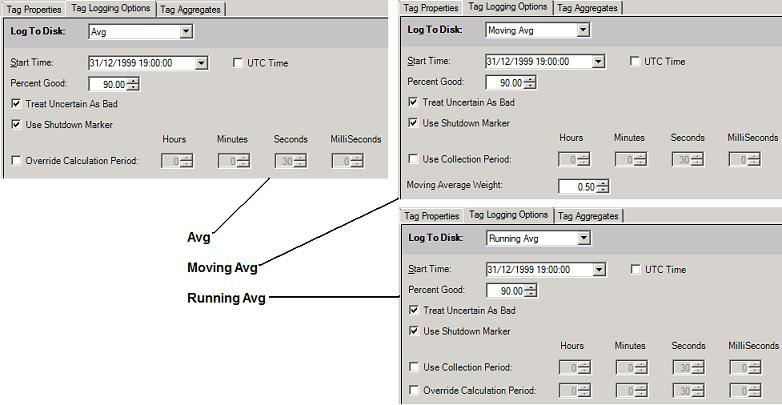
If you want the standard deviation for the calculation period to be sent to the Logger, choose Std. Dev. It is measured as the square root of the variance, or more formally the root mean square (RMS). It is calculated by finding the mean value of all samples, calculating each value's deviation, squaring the deviations, finding the mean of the square and then performing a square root. For a group {1, 4, 7} the mean is 4, the deviations are {3, 0, 3}, the squares of the deviation are {9, 0, 9}, and the standard deviation would be (18/3) ½ or (6) ½ or 2.45.
This option logs the standard deviation value of all samples collected for the tag. It calculates the standard deviation value over the specified calculation period if there is a check mark in the Override Calculation Period check box. If the Override Calculation Period check box is empty, the standard deviation value for all samples ever collected is logged each time a value is collected. Settings for this filter are described in the Settings for Each Log to Disk Filter Option section at the end of this topic.
Settings for Standard Deviation
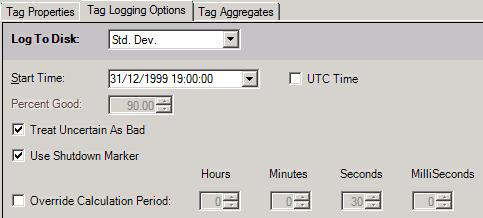
Choose Totalizer for data for which you want to collect a rate and log a current total. Think of it as a counter. The Totalizer gives you a count for a particular period, expressed in the units being collected. When a value is collected, the Totalizer updates the count then logs the count to the logger. Settings for this filter are described in the Settings for Each Log to Disk Filter Option section at the end of this topic.
Settings for Totalizer
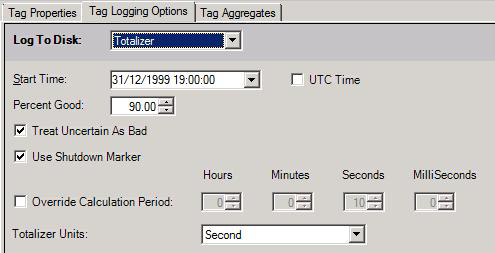
The following examples illustrate uses for the Totalizer option:
For a signal that comes from a flow rate gauge that measures liters, the Totalizer gives you the total number of liters that pass through during an interval that you specify, such as liters per minute.
For an electrical power gauge that measures kilowatts, the Totalizer gives you the total energy consumed during a measured interval, such as kilowatts-hours.
The totalized count is independent of the sampling rate; for example, energy consumed is the same regardless of how often you query the power gauge. Although, if the source oscillates at about half of the sampling frequency or faster, the result it gives you may be inaccurate; for this reason, you should carefully consider the collection rate being used.
If you want the last value received in the calculation period sent to the Logger, choose Most Recent On Time ‡. The last value collected during the calculation period is the value that is sent to the logger; all other values are discarded. You might use this if you need a second-by-second reading in memory but want to log a reading every 5 minutes.
Settings for Most Recent On Time (Using a Time Interval)

You can choose to log the most recent data value at a certain time interval or at specific dates and times. If you choose this second option under Recurrence type, the dialog changes slightly. In particular, the Recurrence details area will display options relevant to the unit of time that you select in the Recur every option. In the example below, the logger will log data at 11:00:00 AM, 11:30:00 AM, 6:00:00 PM, and 6:30:00 PM (local server time) every fifth day, starting at 12:14:33 PM (local server time) on Monday, June 25, 2012.
Sample Settings for Most Recent On Time (Specific Dates and Times)
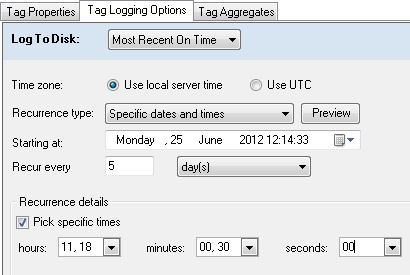
No matter which recurrence type you select, however, you can select a starting date easily by clicking on the calendar icon to the right of the date and time. A calendar opens, where you can select the date on which you would like the tag logging filter to become active.
In this table, each Log to Disk filter's settings are identified. The settings for each Log to Disk filter are described below the table.
|
Settings: |
Log to Disk Options: |
|||||||||||
|
Max |
Min |
Avg |
Std Dev |
Totalizer |
Running Max |
Running Min |
Running Avg |
Moving Max |
Moving Min |
Moving Avg |
Most Recent on Time |
|
|
Start Time |
♦ |
♦ |
♦ |
♦ |
♦ |
♦ |
♦ |
♦ |
♦ |
♦ |
♦ |
|
|
UTC Time |
♦ |
♦ |
♦ |
♦ |
♦ |
♦ |
♦ |
♦ |
♦ |
♦ |
♦ |
|
|
Percent Good |
♦ |
♦ |
♦ |
♦ |
♦ |
♦ |
♦ |
♦ |
♦ |
♦ |
♦ |
|
|
Treat Uncertain as Bad |
♦ |
♦ |
♦ |
♦ |
♦ |
♦ |
♦ |
♦ |
♦ |
♦ |
♦ |
|
|
Use Shutdown Marker |
♦ |
♦ |
♦ |
♦ |
♦ |
♦ |
♦ |
♦ |
♦ |
♦ |
♦ |
|
|
Override Calculation Period |
♦ |
♦ |
♦ |
♦ |
♦ |
♦ |
♦ |
♦ |
♦ |
♦ |
♦ |
|
|
Totalizer Units |
|
|
|
|
♦ |
|
|
|||||
|
Use Collection Period |
|
|
|
|
|
♦ |
♦ |
♦ |
♦ |
♦ |
♦ |
|
|
Moving Avg Weight |
|
|
|
|
|
|
|
|
♦ |
|
||
|
Time Zone |
|
|
|
|
|
|
|
|
♦ |
|||
|
Recurrence Type / Preview |
|
|
|
|
|
|
|
|
|
|
|
♦ |
|
Starting At |
|
|
|
|
|
|
|
|
|
|
|
♦ |
|
Recur Every |
|
|
|
|
|
|
|
|
|
|
|
♦ |
|
Recurrence Details |
|
|
|
|
|
|
|
|
|
|
|
♦ |
Settings for Log to Disk filters are described below:
